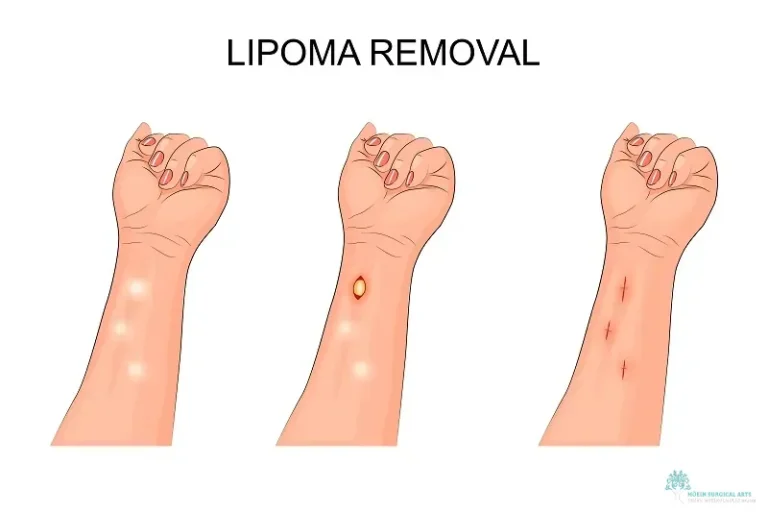
Lipoma removal is a minimally invasive surgical procedure used to excise benign fatty tumors known as lipomas. Though lipomas are typically harmless, they can lead to discomfort from friction with clothing or movement and sometimes cause self-consciousness due to their appearance. At Dr. Babak Moein’s practice, expert dermatologic and surgical teams ensure that you receive supportive, personalized care from the initial consultation through postoperative follow-ups. The procedure is usually performed under local anesthesia, which minimizes discomfort and allows many patients to return home the same day. Postoperative care is straightforward with clear instructions provided to optimize healing and reduce complications.
Lipomas are one of the most frequently encountered benign soft tissue tumors. Studies suggest that roughly 1 in every 1,000 individuals develops a lipoma. They tend to appear more often in middle-aged adults (between 40 and 60 years old), though they can occur at any age. While lipomas affect both men and women, research has indicated a slightly higher occurrence in women. In many cases, lipomas remain unnoticed as they rarely cause pain or interfere with daily activities unless they grow in a location that triggers irritation.

Lipomas usually present as soft, doughy, and well-circumscribed lumps under the skin that are freely mobile. Most lipomas are small—typically less than two inches in diameter—and painless. However, in some cases, they may become tender or cause discomfort if they press against nearby nerves or if their size interferes with normal movement. They are most commonly found on areas such as:
Because lipomas are typically slow growing, any rapid changes in size, pain, or changes in consistency should be evaluated by a healthcare professional.

Although lipomas can technically develop anywhere on the body, they are most frequently observed just beneath the skin (subcutaneously) in the neck, upper back, shoulders, and trunk. Less commonly, lipomas can occur within deeper tissues, such as within muscles or even in rare instances within internal organs. When multiple lipomas occur, it may sometimes indicate an underlying genetic predisposition known as familial multiple lipomatosis.
The exact cause of lipoma formation remains uncertain, but several theories have been proposed:
Although research continues to investigate the pathogenesis, genetic predisposition remains one of the more accepted factors linked to lipoma development.
Diagnosis typically begins with a careful physical examination where your doctor will evaluate the lump’s size, consistency, and mobility. In some cases, imaging studies such as an ultrasound, CT scan, or MRI may be used to confirm the diagnosis and rule out other conditions. When necessary, a biopsy is performed to ensure that the growth is benign and to differentiate it from other soft tissue tumors like liposarcomas. A complete diagnostic workup—physical evaluation combined with imaging and occasional tissue sampling—helps to establish a clear diagnosis.
For most lipomas that do not cause discomfort or cosmetic concerns, treatment may not be required. However, if removal is desired due to symptoms such as pain, irritation, or self-consciousness, the primary treatment methods include:
This is the most definitive treatment where the entire lipoma is removed through a small incision. Surgical excision ensures complete removal and minimizes the chance of recurrence. The procedure is generally performed on an outpatient basis under local anesthesia.
In selected cases—particularly for larger, more diffuse lipomas—liposuction may be used to aspirate the fatty tissue. This method is less invasive and can reduce scarring, though it may not always remove the lipoma entirely.
For very small or asymptomatic lipomas, conservative management with observation and periodic check-ups may be sufficient. Steroid injections have been used in some instances to shrink lipomas, although they are less common than surgical methods.
At Dr. Babak Moein’s clinic, every step of the lipoma removal process is designed for your comfort and optimal outcomes:
The overall prognosis for individuals undergoing lipoma removal is excellent. As benign tumors, lipomas do not pose significant health risks and are unlikely to recur if entirely removed. The procedure offers both physical relief from irritation or discomfort and psychological benefits through improved body image.
Lipoma removal is a simple yet effective solution for managing benign fatty tumors that may cause discomfort or aesthetic concerns. At Dr. Babak Moein’s practice in Los Angeles, patients benefit from expert surgical techniques, a comfortable care environment, and comprehensive follow-up care. If you have a lipoma that is causing issues or if you’re simply looking for improved confidence and comfort, consult with Dr. Moein to explore your treatment options.